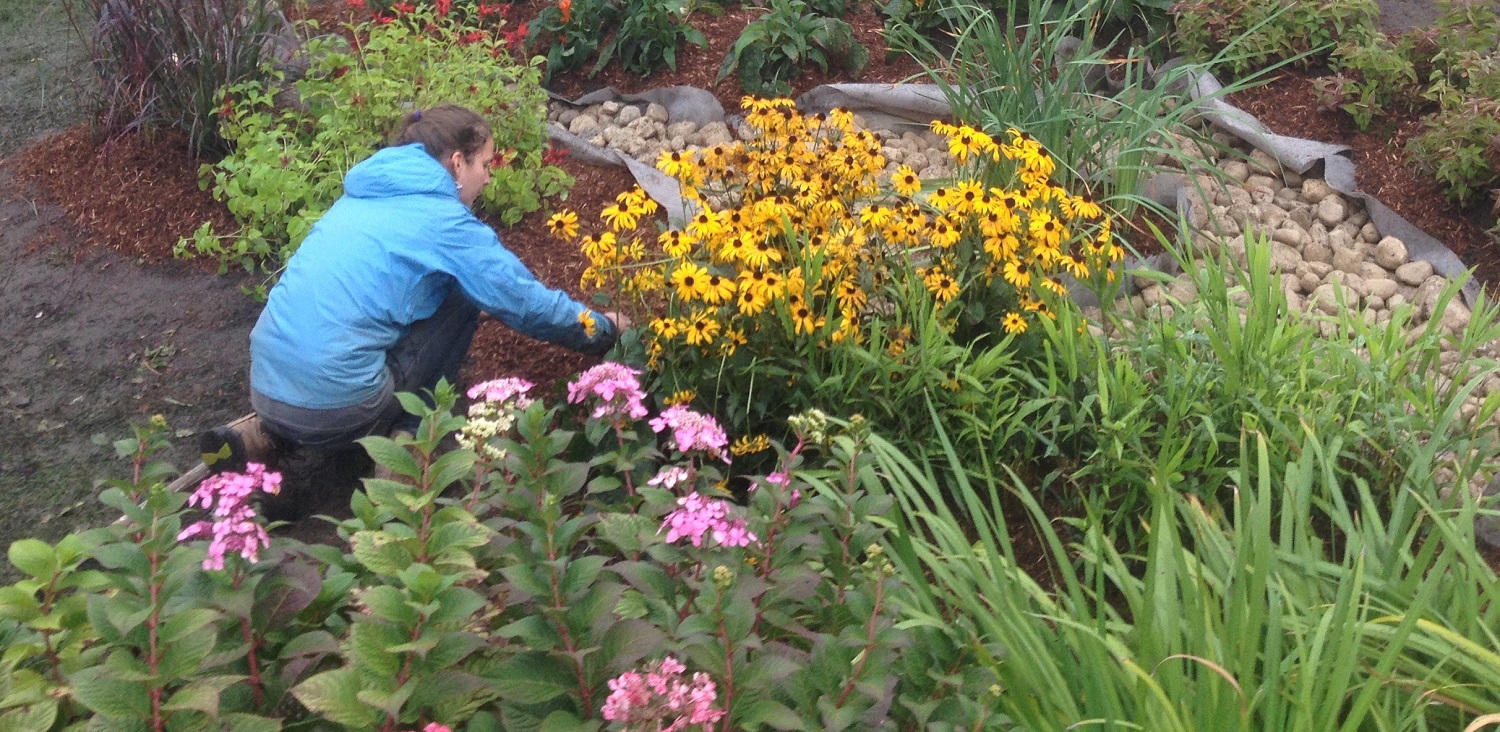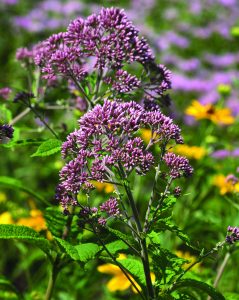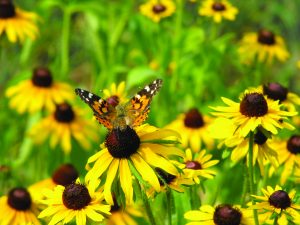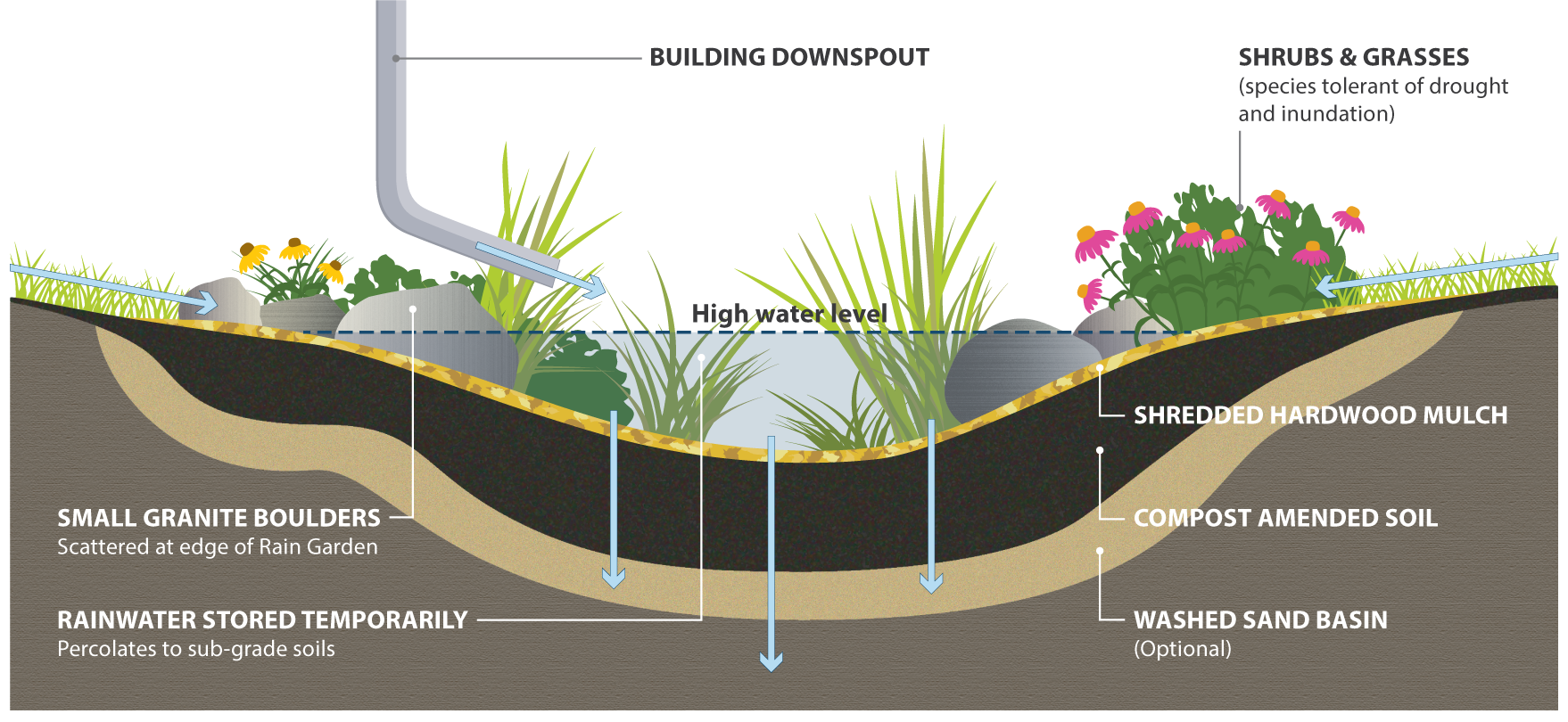Can I Put A Tree Right Next To A Rain Garden
This article has been created from the TRCA Healthy Yards fact sheet and guide.
What is a rain garden?
A rain garden is a landscaped feature that replaces an area of your lawn in order to collect the stormwater (rain and melted snow) that runs off your grass, roof and driveway. This shallow depression has loose, deep soil that absorbs and naturally filters the runoff, preventing it from entering the storm drain system and, eventually, our waterways.
Rain gardens complement any style of landscape and can be adapted to personal preferences. They can be large or small and can take advantage of pockets of space in your yard.

Why build a rain garden?
Rain gardens are not only beautiful and creative, they are also functional. By planting a rain garden, you can help maintain the natural water cycle while protecting local rivers, lakes, fish and drinking water sources.
Rain gardens:
- Limit the amount of water that enters the local storm drain system
- Reduce the potential for flooding, drainage problems and stream bank erosion
- Reduce the quantity of pollutants that run from our yards and roads straight into our waterways
- Restore and recharge our groundwater system
- Are low maintenance. They are planted with beautiful, hardy plants that require little to no watering
- Attract birds, butterflies and beneficial insects, such as mosquito-consuming dragonflies
- Complement any style of landscape and enhance the beauty of the surrounding neighbourhood.
Compared to a patch of lawn, a rain garden allows about 30% more water to soak into the ground!
Garden for Cleaner Water
What is stormwater runoff?
Stormwater runoff is the water that runs over and off the land during a rainstorm or snowmelt, rather than soaking in.
#LivingCityReport: Stormwater #runoff is the main cause of stream water pollution in the #GTA. #WorldWaterDay https://t.co/lsJWVv3eyA pic.twitter.com/2YdcwciiwQ
— TRCA News (@TRCA_News) March 22, 2017
What is the problem?
As stormwater runs over streets, parking lots, and lawns it can pick up and carry many kinds of materials that get washed into storm drains. Storm drains are specialized drainage systems designed to handle an excess of water from flooding or heavy rainfall. They lead directly into the nearest water body. Large objects are screened out, but the water is not filtered and is carried to nearby streams and lakes. This leads to stormwater pollution!
Where do these pollutants come from?
Stormwater picks up contaminants including:
- Fertilizers
- Pesticides
- Bacteria from pet waste
- Eroded soil
- Road salt
- Grass clippings
- Litter
Just to name a few! These pollutants wash into ditches and down storm drains, and end up in local waterways. Rain gardens capture and filter stormwater, helping to reduce runoff. While an individual garden may seem like a small thing, collectively they can produce substantial benefits to the community. -Text Credit: Christopher Obropta, Ph.D, P.E., Extension Specialist, Rutgers Cooperative Extension, Water Resources Program
Is a rain garden right for me?
- Do you have a low lying area on your property where water naturally flows during a heavy storm?
- Are you interested in installing a new garden, or do you have an existing garden that you would like to redesign?
- Is your potential garden space at least 3 metres away from any building foundation on your property?
- Is your potential garden space relatively flat? (between 1% and 5% slope)
- Is there a source of water to feed your potential garden space, such as a downspout or a rain barrel?
If you answered 'YES' to all of the above, you are ready to install your rain garden!
Getting Started
The best gardens start with a well laid out plan. This is especially true for rain gardens. There are three things to consider when planning your new rain garden:
- Location
- Style
- Size

Location
Where will the water come from? Water can be carried to your rain garden in a variety of different ways. It can be carried through an extension on the end of your downspout, through an infiltration trench lined with plants or decorative rocks, or through the overflow pipe from your rain barrel.
Redirecting a downspout is the easiest way to carry water to your rain garden. Depending on the size and location of your property, you can even consider directing more than one downspout toward your rain garden.
Rain gardens can be placed in more than one location, depending on your space and how ambitious you're feeling. For example, you can direct water from your rain barrel to a rain garden in your backyard, and water from your downspouts to a rain garden in your front yard.
There are a few locations on your property that ARE NOT appropriate for rain gardens:
- To prevent water from getting into foundations and causing basement flooding, rain gardens should always be at least three metres away from your home, garage and any neighbouring properties.
- Rain gardens should never be placed within 4 metres of a septic bed, and if uphill of a septic system, they should be at least 15 metres away.
- Rain gardens placed near any type of steep slope (more than 15%) have the potential to cause land slides because of the excess water being absorbed into the soil. Rain gardens should not be installed within 15 metres of any steep slopes on or around your property.
- Before doing any digging for this project, you must locate and mark all underground utilities. Some utilities are quite shallow and you can be held liable if you hit them without obtaining the proper dig permits first. Use the Ontario One Call online locate form to locate underground infrastructure before you dig or call 1-800-400-2255.
- Areas of poor drainage are not likely good options for rain gardens. However, you can potentially amend the soil to make it suitable for a rain garden.
What's your style?
There are many different styles of rain gardens to choose from. Whether you like a formal landscape, or a more casual country look, you can create a rain garden that you will love. The options are endless!

There are a few demonstration rain gardens in the Greater Toronto Area that you can visit for inspiration:
- Humber Arboretum (205 Humber College Boulevard, Toronto)
- County Court demonstration rain garden (71 Turtlecreek Boulevard, Brampton)
- Kortright Centre for Conservation, Archetype House Gardens (9520 Pine Valley Drive, Vaughan)
- Markham Museum (9350 Markham Road, Markham)
- Lake Wilcox demonstration rain gardens (20 Wheatsheaf Street, Richmond Hill and 95 Wheelright Drive, Richmond Hill).
A selection of native plants for your rain garden
Rain garden plants need to tolerate both wet and dry conditions. This is because rain gardens experience alternate flooding (following a large rain storm) and drought (during periods of low rainfall). Any combination of flowers, shrubs, grasses or ferns that meet these criteria will do well in a rain garden. Native plants are always recommended for rain gardens because they are well suited to local growing conditions, and support local wildlife including birds and butterflies.






The following is a list of native wild plants for rain gardens, identified based on the light conditions they grow well in:
Grasses
- big bluestem (Andropogon gerardii) – sun, partial sun
- Canada wild rye (Elymus Canadensis) – sun, partial sun, shade
- tufted hairgrass (Deschampsia cespitosa) – sun, partial sun
- little bluestem (Schizachyrium scoparium) – sun
Flowering herbaceous plants
- wild columbine (Aquilegia canadensis) – sun, partial sun
- butterfly weed (Asclepias tuberose) – sun
- white turtlehead (Chelone glabra) – sun, partial sun, shade
- showy tick-trefoil (Desmodium canadense) – sun, partial sun
- spotted Joe-pye weed (Eupatorium maculatum) – sun, partial sun
- oxeye sunflower (Heliopsis helianthoides) – sun
- wild bergamot (Monarda fistulosa) – sun, partial sun
- black-eyed Susan (Rudbeckia hirta) – sun, partial sun
- New England aster (Symphyotrichum novae-angliae) – sun, partial sun
- swamp milkweed (Asclepias incarnata) – sun, partial sun
Shrubs
- red-osier dogwood (Cornus sericea) – sun, partial sun
- eastern ninebark (Physocarpus opulifolius) – sun, partial sun
- nannyberry (Viburnum lentago) – sun
- common elderberry (Sambucus canadensis) – sun, partial sun
Designing Your Rain Garden
There are a few things you might want to think about when designing the look of your rain garden:
- Choose a variety of plants, including shrubs, flowers and grasses, to create variety in colour, height and texture.
- Consider the year-round look of your rain garden – clumping grasses will hold their shape throughout the winter, and many types of shrubs develop striking red branches in the colder months.
- Consider your home's existing landscape, and the landscaping of the surrounding neighbourhood.
- If the rain garden is near the road, consider sight lines and set backs.

Building Your Rain Garden
Tools Required:
- Shovels
- Ground paint or string
Materials Required:
- Mulch
- Sand/compost mix
- A collection of small rocks and stones
- A variety of native plants

Steps:
1. Digging your rain garden
Before you even pick up a shovel, mark out your rain garden area to make sure you are happy with the size and how it will look. Ground paint, or string tied to wooden stakes are both easy ways to mark the area, and let you make changes if you would like. You should also mark out the area where water will get to your rain garden, and where the water overflow area will be (refer to step 3 for more information).
Once you are happy with the layout for your new garden, it's time to start digging. Rain gardens should be dug to a depth of approximately 85 centimetres (or deeper if you're building a small rain garden). The ground under a rain garden should not be packed down, so try to stand outside of the garden area as much as you can, and avoid placing any heavy instruments or machinery inside the digging area.
2. Soil for your rain garden
Once you have finished digging your garden area, it's time to fill it back up with rain garden soil mix. This is one of the major differences between building a rain garden and building a regular garden; rain gardens require a special soil mix to work properly. This soil mix usually contains a combination of compost and sand and is designed to allow water to infiltrate easily and quickly.
Soil mix should be added to your excavated rain garden area to a depth of approximately 60 centimetres (this will leave approximately 25 centimetres for plants, mulch and water pooling – remember, rain gardens should be sunken into the ground to allow rain water to collect and filter into the soil). When filling with soil, lightly tamp down the area with your feet every 20 centimetres or so to help the soil settle.
3. Getting water to the rain garden and providing an area for overflow
You need to create the inlet (area for water to enter the rain garden) and the overflow (area for water to exit the rain garden in case of overfilling).
Creating an Inlet
Water can be carried to your rain garden in a variety of different ways. It can be carried through an extension on the end of your downspout, across a landscaped area, through an infiltration trench lined with plants or decorative rock , or through the overflow pipe from your rain barrel. A few small stones should be placed around the spot where water will enter the rain garden to slow the water and protect the soil from being washed away.
Creating an Overflow
During most of the year, all the water that flows into your rain garden will soak into the ground. Occasionally, when the ground is wet and a big storm occurs, the garden can fill up and overflow. A rain garden needs to have an overflow area to let excess water leave the rain garden. The overflow should be located on the downhill side of the garden, directing excess water towards a second garden or an open area of lawn. As you did with the inlet, you should also place a few small stones around the overflow area to slow the water as it exits and protect the soil from being washed away.
4. Planting your rain garden
Planting your rain garden is the final step. It's best to position all of your plants in the garden before removing them from their containers to make sure you like the layout. Now you can start planting.
Turn the plant's container upside down, give the bottom of the pot a sharp rap, and catch the root ball as the plant slides out from the container. Tease the roots out with your hands – don't worry if you break a few of the roots.
Make sure you do not plant the new plant too deep into the soil. The depth should be equal to the depth in the container. Also, make sure you consider the plant's mature size when spacing them – you don't want to overcrowd your garden. Press the soil firmly around its base and water well. Plants will need to be watered every few days until established (about 4 weeks). Once established, the plants will not need to be watered regularly, except for during times of drought.
Once all of your plants are in, cover your new garden with a 5-10 centimetres layer of mulch. Mulch helps to keep out weeds, resists drought and gives the garden a tidy appearance. Mulch is especially important for rain gardens as it also helps to absorb and filter the rain water. Your layer of mulch should not be more than 10 centimetres deep.
Maintaining Your Rain Garden
A well-designed rain garden needs minimum care. However, just like any garden, it requires some maintenance to look good and function properly. There are five things to remember when maintaining your rain garden over the years.

Mulching
Every year check the mulch layer and, if needed, apply more to maintain a layer that is about 10 centimetres thick. Mulch can be applied any time of the year, but it's usually easiest to remember in spring at the start of the growing season.
Erosion and Debris
Water flowing into the rain garden can carry with it various types of debris that can clog the soil mix and slow drainage. Fast flowing water can also slowly eat away at your soil layer, washing it away and damaging your garden.
To guard against soil erosion and debris build-up:
- Check the rain garden for areas of exposed soil and re-mulch as needed. Mulch helps to absorb water and protect the soil underneath.
- Maintain a healthy cover of plants, and replace any dead plants to fill in holes.
- Maintain a cover of decorative rock around the inlet and overflow area to protect the soil.
- At least twice a year, check around the inlet and overflow areas for debris build-up such as leaves, sticks, and other items. Keep these areas clear to help your garden absorb rain water.
Fertilizing
Do not apply fertilizers to your rain garden. The rain garden soil mix provides plenty of nutrients and the native plants in your garden are well suited to local growing conditions, so extra fertilizing is not needed.
Weeding
Rain gardens will still soak up and filter rain water even if they are full of weeds. However, the plants in the rain garden will likely not grow as well with all the competition and your rain garden may not be as attractive. Soils in rain gardens have good structure, so weeds should be easy to pull by hand, especially in the spring when the soil is moist and the weeds are small.
Watering
For the first year most plants need deep watering during the dry summer season to establish healthy root systems. After two or three years the native plants in your rain garden will need little or no watering. However, watering may be necessary during prolonged dry periods even if plants are established.
Watering Tips
- Water deeply, but infrequently, so that the top 15 to 30 centimetres of the root zone is moist. To know if you're applying enough water, dig down 20 to 40 centimetres off to the side of the plant a few hours after watering— don't disturb the roots. If the ground it wet here, you know you've applied enough water.
- Use soaker hoses to ensure water soaks directly into the soil and isn't lost to evaporation.
- Don't over water. Over watering can rot plant roots and soggy soil reduces oxygen needed for healthy soil and plants.
- Water in the morning or evening to reduce evaporation during warm mid-day temperatures.
Frequently asked questions
Will it be expensive or difficult to install and maintain a rain garden?
Once a shallow depression is dug for the rain garden, it won't be any more expensive than planting other landscaped areas in your yard. Most of the recommended plants can be purchased at local nurseries, and you maintain them just like any other plants in your yard. We recommend using native plants, which once established, will require less water and no fertilization.
Will a rain garden create a pond for mosquitoes?
No, a rain garden is not a pond. When properly constructed, the water will drain within 48 hours (but usually faster). Mosquitoes won't find rain gardens to be good breeding areas because they need much more time to lay and hatch eggs.
When should I seek professional advice?
If your soil is high in clay, it can be challenging to create a highly functioning rain garden. You may want to consult with a landscape professional before proceeding for advice on dealing with your specific soil conditions.
How can I locate utility pipes and wires before digging?
Use the Ontario One Call online locate form to locate underground infrastructure before you dig or call: 1-800-400-2255.
Can I Put A Tree Right Next To A Rain Garden
Source: https://trca.ca/news/complete-guide-building-maintaining-rain-garden/
Posted by: simpsonderignatim.blogspot.com

0 Response to "Can I Put A Tree Right Next To A Rain Garden"
Post a Comment